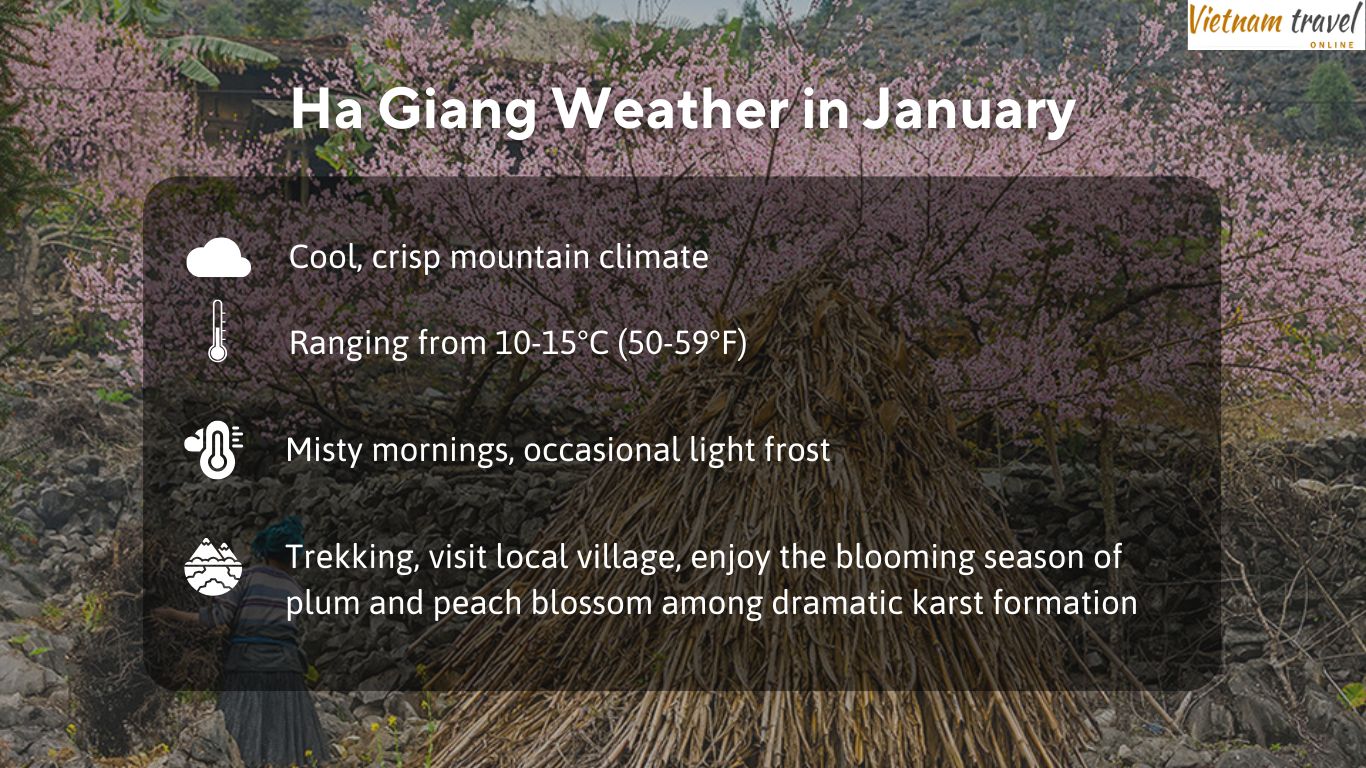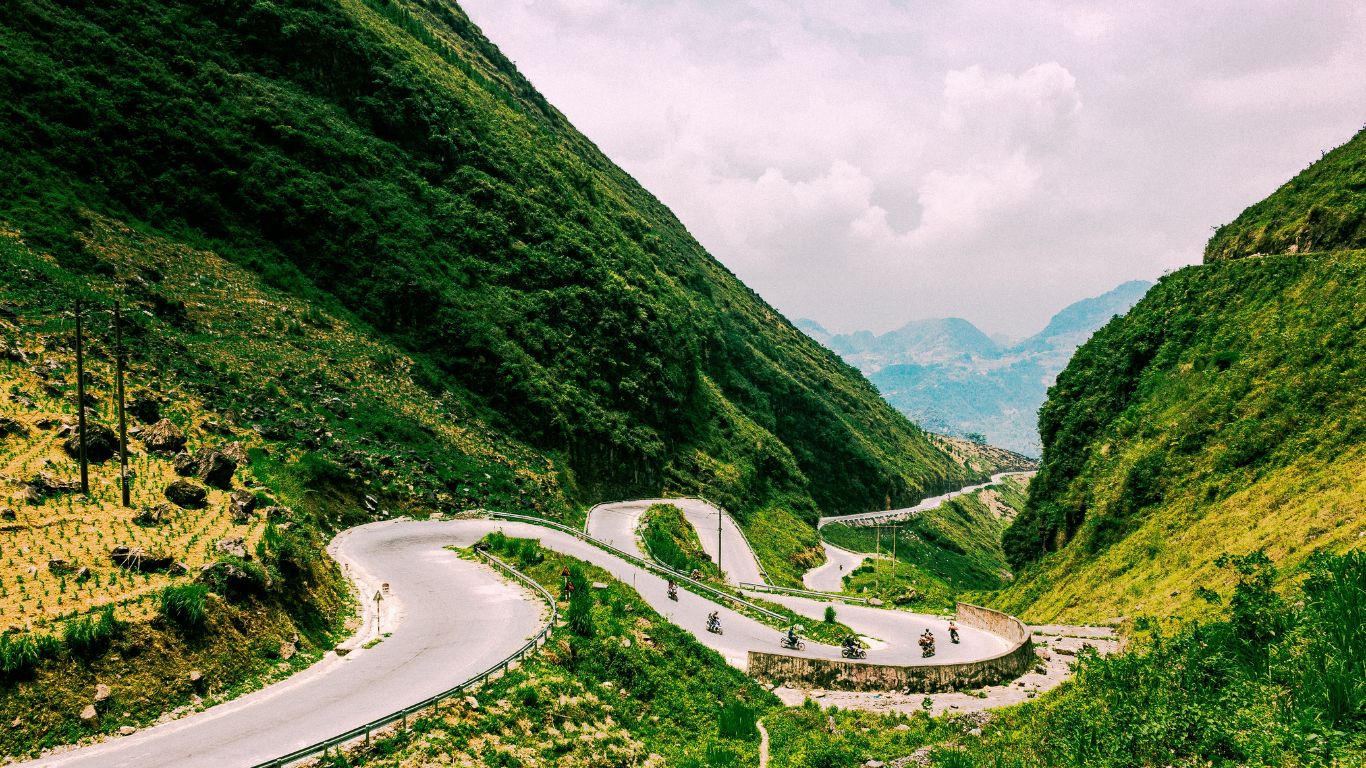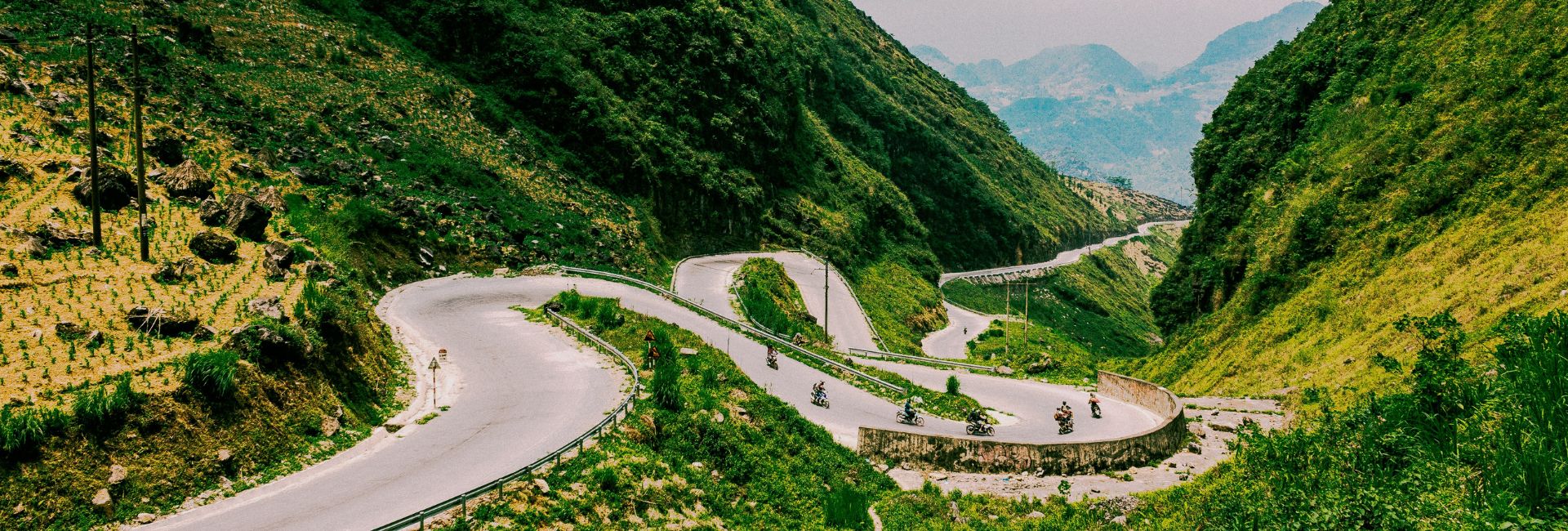Ha Giang Loop in January offers a mesmerizing winter with its cool weather, early flower blooms, and rich cultural experiences, this destination provides a truly unique winter adventure. While it’s a quieter season for tourism, this comprehensive guide reveals insider tips for exploring the breathtaking Northwest Vietnamese region, helping you navigate through stunning landscapes, ethnic minority villages, and hidden gems while avoiding typical tourist crowds.
Here are what you can find in this travel blog:
- Overview Ha Giang Loop weather in January
- Cost & crowd when visiting Ha Giang in January
- Best things to do in January in Ha Giang Loop
- Travel tips for January in Ha Giang
- Suggested itinerary in January in Ha Giang Loop
- Combining Hanoi – Ha Giang – Sapa in January for the best Northwest Vietnam Experience
Overview Ha Giang Loop weather in January

Winter in Ha Giang paints a dramatically different landscape compared to other months, offering a unique travel experience that challenges typical tropical expectations. January brings crisp, cool temperatures ranging from 10°C to 15°C, creating a misty, ethereal atmosphere across the mountainous region.
Compared to peak tourist months like May or October, January offers a more serene and introspective journey. The weather might be chillier, but it transforms the legendary mountain passes into a mystical realm where low-hanging clouds dance around limestone peaks.
You can still enjoy outdoor activities, but it’s a good idea to wear layers and be ready for some light rain or chilly mornings. Activities like hiking, motorcycle rides, and photography are especially beautiful during this season when the trees are bursting with colorful plum and peach blossoms, making the scenery truly enchanting.
Cost & crowd when visiting Ha Giang in January
January is considered part of the peak Vietnamese travel season, however, Ha Giang remains relatively uncrowded compared to more popular destinations like Sapa, Halong Bay, etc. Mostly local Vietnamese travelers populate the area, creating a more authentic cultural experience that feels less touristy and more genuine.
Hotel prices remain reasonable, with most accommodations offering rates that won’t strain your wallet. However, the key recommendation is to book your stay 2-3 months in advance. The limited number of quality accommodations in remote mountain areas means early booking is crucial.
Best things to do in January in Ha Giang Loop
Enjoy the blooming flower season
January marks the beginning of the flower blooming season in Ha Giang. Particularly fascinating are the plum and peach blossoms that start to emerge, painting the mountainsides with delicate white and soft pink hues. These early blooms provide a stunning contrast against the rocky terrain, creating picture-perfect moments that seem almost unreal.

Learn about Hmong Indigo dyeing
Winter is an excellent time to dive deep into cultural experiences. The Hmong communities are often more available during this quieter season, willing to share traditional crafts like indigo dyeing. You’ll have the opportunity to learn about intricate textile-making processes that have been passed down through generations, gaining insights into a rich cultural heritage.

Ma Pi Leng pass viewpoint
Arguably one of the most dramatic landscapes in Vietnam, Ma Pi Leng Pass offers breathtaking views that are particularly spectacular in January. The cooler, clearer air provides exceptional visibility, allowing you to see deep into the valleys and appreciate the sheer scale of the mountainous terrain. Early morning mists add an extra layer of mystique to this already stunning location.

Experiencing a local market
Local markets in January buzz with pre-Lunar New Year energy. You’ll witness communities gathering, trading goods, and preparing for the most important festival in Vietnamese culture. The markets become vibrant social spaces where traditional clothing, fresh produce, and handmade crafts tell stories of mountain life.

Immersing yourself in ethnic minority culture
January provides a unique window into the daily lives of ethnic minority communities. With fewer tourists around, you’ll have more genuine interactions with local families. Traditional winter activities like community gatherings, craft-making, and preparing for the upcoming Lunar New Year become accessible experiences.
Trekking through beautiful villages
Winter trekking in Ha Giang offers a different kind of beauty. The trails are less muddy compared to the rainy season, and the cooler temperatures make hiking more comfortable. Villages like Dong Van and Meo Vac become magical landscapes where traditional stone houses stand against misty mountain backgrounds.
Travel tips for January in Ha Giang
- Clothing essentials: Pack warm, layerable clothing for the cool mountain climate. Bring thermal base layers, waterproof jackets, and sturdy hiking boots that can handle occasional frost and muddy trails.
- Financial planning: Always carry cash, as many small villages and local markets don’t accept credit cards. Prepare small denominations for easier transactions in remote areas.
- Transportation safety: Carefully consider transportation options. If renting a motorbike, ensure you have previous mountain driving experience. For less confident travelers, hiring a local driver or joining a guided tour is the safest and most recommended option.
- Accommodation booking: Book accommodations in advance, especially in smaller villages. Winter is a popular time for local travelers, and options can be limited in remote areas.
- Local cuisine preparation: Be open to local food but also carry some familiar snacks. Mountain villages may have limited dining options, so it’s wise to be prepared with some backup food supplies.
Suggested itinerary in January in Ha Giang Loop
Day 1: Hanoi – Drive to Ha Giang
Begin your journey early from Hanoi, embarking on a scenic drive towards Ha Giang. The approximately 6-7 hour journey takes you through changing landscapes, from bustling cities to mountainous terrain. Arrive in Ha Giang by late afternoon, settling into your accommodation and preparing for the adventures ahead.
Day 2: Ha Giang – Quan Ba – Dong Van Plateu
Wake up to the misty mountain morning and head towards the breathtaking Quan Ba area, often called the “Heaven’s Gate.” The journey offers spectacular views of karst landscapes and traditional ethnic minority villages. Spend time exploring the Dong Van Plateau, with its unique geological formations and rich cultural heritage. Visit local markets and interact with H’mong and Tay communities, gaining insights into their winter lifestyle.
Day 3: Dong Van – Trek through off-the-beaten-path villages – Visit H’mong local people’s home
Spend this day enjoying a unique hiking adventure through hidden villages. Meet local H’mong families, discover their traditional lifestyles, and see how they manage to live and thrive in the cold mountains during winter. This genuine cultural experience will be a memorable part of your trip, giving you insights that go beyond the usual tourist sights.
Day 4: Dong Van – Meo Vac – Quan Ba
Experience the breathtaking Ma Pi Leng Pass, which is often regarded as one of the most beautiful mountain roads in Vietnam. In winter, you’ll be treated to stunning views of deep valleys and impressive mountains. Discover the Meo Vac area, famous for its stunning scenery and vibrant mix of cultures. Don’t forget to take plenty of photos and soak in the unique mountain lifestyle!
Day 5: Quan Ba – Transfer back to Hanoi
Complete your Ha Giang adventure with a scenic journey back to Hanoi. Reflect on the incredible experiences, unique landscapes, and cultural encounters that make Ha Giang such a special destination during the winter months.
Combining Hanoi – Ha Giang – Sapa in January for the best Northwest Vietnam Experience
The northern region of Vietnam transforms into a magical landscape during winter, with each destination offering its unique charm. Hanoi experiences cool, dry weather with temperatures ranging from 15-20°C, while Ha Giang sees cooler temperatures around 10-15°C. Sapa becomes particularly mystical, with light frost and temperatures dropping to 8-12°C.
The North stands out as Vietnam’s premier destination in January, offering you an unparalleled combination of natural beauty, cultural richness, and unique winter experiences.
When planning your Northwest Vietnam adventure, allocate approximately 7 days to fully immerse yourself in the region’s diverse experiences. Here’s a breakdown of recommended time for each destination:
- Hanoi: 1-2 days for urban exploration and preparation
- Ha Giang: 2-3 days to explore mountain landscapes and ethnic cultures
- Sapa: 1-2 days for trekking and cultural experiences
For further details about activities and estimated prices, you can check out our Insightful Northwest Adventure 7 Days. This route allows you to experience the diversity of Northwest Vietnam – from bustling cities to remote mountain villages, from geological wonders to rich cultural tapestries. As we specialize in organizing PRIVATE TOURS, your itinerary is customizable to match your travel interests.
January is an extraordinary time to discover Ha Giang’s unparalleled beauty, offering travelers an intimate glimpse into Vietnam’s most dramatic mountainous region. If you’re still unsure when to go, it’s better to read more on our travel blog about the best time to visit Ha Giang to have an overview and see what are the main highlights by season.






